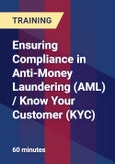This program will help attendees understand the background to today’s AML and KYC compliance requirements; become familiar with the different aspects of Money Laundering; and be aware of the obligations of employees concerning AML and KYC.
In this webinar you will learn how Money Laundering works in practice; become familiar with the different aspects of Money Laundering (Placement, Layering and Integration); and gain a fuller understanding of the obligations of employees and managers concerning AML and KYC.
In this training we will discuss real AML/KYC situations that have arisen, and the decisions that had to made concerning them. We will also discuss AML/KYC software tools: both the uses and the hazards/risk exposures involved.
Why Should You Attend:
Banks, Credit Unions and some other financial institutions have far reaching obligations under the relevant laws, including the requirement to know who their customers are (not just who they appear to be); and to co-operate fully in preventing Money Laundering. This is not merely theoretical: fines of as much as $700 million have been imposed for AML violations.In this webinar you will learn how Money Laundering works in practice; become familiar with the different aspects of Money Laundering (Placement, Layering and Integration); and gain a fuller understanding of the obligations of employees and managers concerning AML and KYC.
In this training we will discuss real AML/KYC situations that have arisen, and the decisions that had to made concerning them. We will also discuss AML/KYC software tools: both the uses and the hazards/risk exposures involved.
Areas Covered in the Webinar:
- Duties imposed by applicable laws, including the Bank Secrecy Act (BSA); the Annunzio-Wiley Anti- Money Laundering Act; and the Foreign Corrupt Practices Act (FCPA)
- Organizations administering AML rules and programs, including FinCEN (Financial Crimes Enforcement Network) in the US Treasury Department
- How ‘Know Your Customer’ (KYC) works in practice
- The three components of Money Laundering: Placement, Layering and Integration
- How Money Laundering works in practice
- The requirement to file Suspicious Activity Reports (SARs) and Suspicious Transaction Reports (STRs)
- The role of e-filing of SARs and STRs through FinCEN’s BSA e-filing system
- Case examples of AML and KYC problems, how they were handled, and what can be learned
Who Will Benefit:
- Employees and managers in banks or credit unions who make decisions concerning customer transactions, especially those with account responsibility for specific customers, and those with supervisory responsibilities
- Compliance staff and management
- Employees and managers in the Risk function in banks or credit unions
Speaker
Michael TylerCourse Provider

Michael Tyler,









